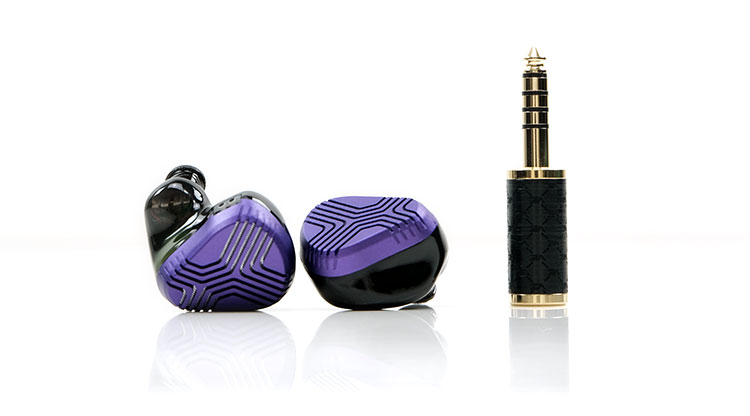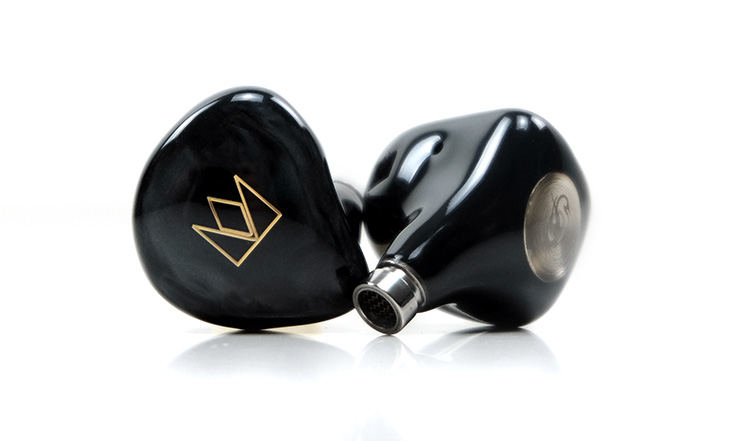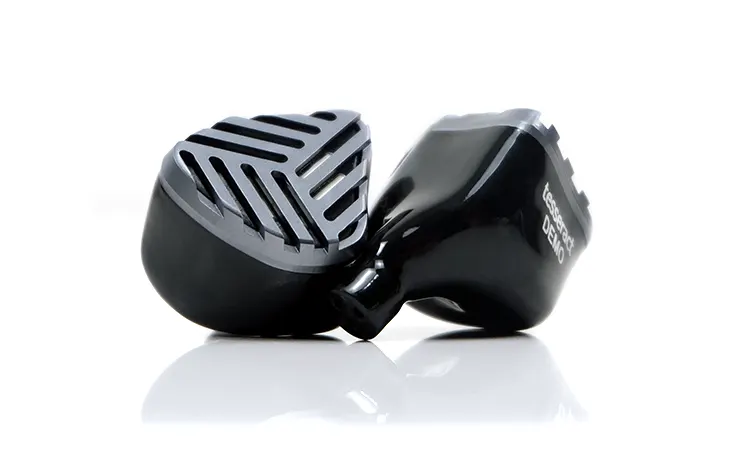Select Comparisons
The following comparisons to the SR11 were completed using a mix of the HiBy RS8, the Cayin N8ii, and the Chord Electronics Mojo 2. All monitors were fitted with their balanced 4.4mm stock cables and best-performing stock tips.
Vision Ears EXT
The Vision Ears EXT was launched in late 2021 and is available in a universal format only. It was also our Top Gear Co-awardee for that same year. You can read our full review of the EXT here.
Technical
Like the SR11, the EXT is a hybrid monitor but unlike the SR11 it uses dynamic and EST with no balanced armature drivers.
The precise configuration is a 9.2mm dynamic driver for the lows, a smaller 6.2mm dynamic driver for the mids, and a quad electrostatic driver array for the highs including a 3-way crossover.
This will present a very different feel and timbre on the lows and mids with the 11-driver SR11 using a mix of BA and its 10mm dynamic for the lows, mids, and part of its top-end.
You also have to remember also the SR11 uses the EST drivers for the ultra-highs whereas the EXT EST drivers reach down a bit more into the audio treble range and are not purely targeting the ultra-highs.
I am going to presume that like the EXT the SR11 uses 2nd generation Sonion energizers which are more efficient than the first EST hybrid IEMs to hit the market in 2019.
Both of these, at least on paper, seem easy enough to drive with the EXT rated at 10Ω and 108.5db @1kHz SPL and the SR11 at 14Ω and an even more sensitive 114 dB @1kHz.
However, testing with the balanced low gain output on a HiBy RS8, the EXT was considerably less sensitive compared to the SR11 forcing me to bump up the volume by a noticeable amount.
Design
Of the four models here, the EXT is the smallest and just slightly smaller than the SR11. Weight-wise they are quite similar with the EXT carrying a little more on top with its aluminum plate.
Both models use a matte black resin shell with the SR11 more aggressively contoured though I doubt you can do much contouring with the EXT given how small it is.
Aesthetically, the EXT is more striking looking with that purple futuristic aluminum plate and Tron-like grooves running through it. The SR11 is attractive but it lacks the punch and immediacy of the VE aesthetics.
The EXT has a clever ’90-degree’ angle on the nozzle bend. That allows for a deeper insertion also creating a flusher fit in the ear. I do find it very secure, perhaps even more so than the SR11 though the EXT can be tougher to get out of your ear.
That being said, both of these monitors passively isolate equally as well as each other. They are tip-dependent though and do have similar wide nozzles which has a nice bonus of being compatible with each other’s tip selection.
Both monitors use 8-wire stock cables. The EXT cable is a 1.2m 28AWG 8-wire SPC insulated in 200d Kevlar and finished with a black PVC jacket whereas the SR11 version has a transparent softer PVC and an 8-wire high-purity silver-plated copper Litz geometry.
Both handle well but of the two the SR11 cable has a softer jacket and slightly better handling. The EXT cable is not as wide and has better finishing on the plug and splitter barrels but it does not have the interchangeable connector system. Instead, you get a 4.4mm converter for its 2.5mm termination and no 3.5mm SE option.
Performance
Some very distinct differences between these two monitors with the EXT my pick for anything that requires the fullest tones on the lows and the SR11 for punch and vocal presence.
For me, the EXT is a little more L or V-shaped with the SR11 playing more to a traditional Harman-like curve. Both extend well into the lows with some excellent reach; however, the EXT carries a little more elevation from 80-300Hz whereas the SR11 is a shade flatter through the same region.
That results in the additional warmth you hear from the EXT and the perception of more body at the same time. The SR11 is more neutral through the same region but carries with it an excellent mid-bass punch and perhaps a sliver of sub-bass shaved off but not by much. With the SR11, the bass to mids separation is greater compared to the EXT.
Through the mids, the SR11 is more forward-sounding. The EXT plays south of a typical Harman elevation from 2-5k with more energy from 800Hz to a peak at 2k. It’s not a huge peak but enough to give vocals in this region a necessary lift.
The SR11 has a stronger more intimate vocal presence and a timbre that is generally more neutral. It gives the EXT equivalent more of a diminished vocal presence but also a comparatively more euphonic or smoother tone.
The EXT EST timbre and tuning are fairly easy to pick up with an upper treble lift that gives dynamic peaking in higher register notes a bit of an ethereal light tone. The SR11 has more of a lower treble focus around 5-8k which produces more solidity and good headroom but comparatively less upper treble energy.
Noble Audio Kublai Khan
The Noble Audio Kublai Khan was launched in 2022 with our subsequent review coming out in early 2023. This is the successor to the older Khan launched in 2019. You can read our full review of the highly-rated Kublai Khan here.
Technical
Both of these monitors are ‘tribrid’ driver configurations by design with the Kublai Khan a little lower at 7 drivers compared to 11. However, rather than using the SR11’s Quad-EST driver array the Kublai Khan uses a 10mm Piezoelectric super tweeter for the highs to the ultra-highs as well as a bone conduction driver for the lows.
The main physical difference between a piezo and an EST driver is that piezoelectric transducers use a ceramic material to receive and conduct an electric charge whereas electrostatic transducers contain a thin metal membrane.
The Kublai Khan’s bone conduction driver covers a low-frequency range and targets its 10mm dynamic driver and low-end presentation to create a more tactile response. The SR11 also uses a 10mm dynamic but mixes in a dual-woofer BA for the lows. The dynamic driver focuses purely on the sub-bass and the dual woofer BA’s for the mid and upper-bass.
The mids have a similar BA driver composition for both monitors. However, the SR11 ups the driver count from the Kublai Khan’s 4 to a total of 6.
The Kublai Khan does not have an official impedance and sensitivity rating and it is advertised as being relatively sensitive and under 30Ω.
Our real-world testing with a balanced P+ low gain connection from the Cayin N8ii gave us an impression of the SR11 being the more sensitive of the two so we would hazard a guess that the Kublai Khan is quite a bit less than 112 dB @1kHz for SPL.
Design
A hugely different approach, at least in terms of the form factor with the Kublai Khan dwarfing the more petite SR11. No question which one is the comfier in the ear, it’s the SR11 with its more aggressive contouring and more compact dimensions.
The Kublai Khan is really designed to go deep into your ear with that long nozzle build. The SR11’s shallower shape allows it to sit closer to your ear canal on your ear’s concha basin so it’s not required to have a long nozzle.
Both isolate really well but I give a slight edge to the Khan simply because they come with foam tips which are great for blocking out more noise than silicone but at the cost of some additional canal pressure.
The aesthetics between these are not hugely different. Both have black resin builds though the Khan’s dragon motif and stainless steel spout give it a little bit of difference whereas the SR11 has a more blended color scheme. Also, the huge silver disc at the base of the Khan for the bone conduction driver further differentiates.
Both come with 8-wire cables, the Khan uses Noble’s own 1.2m 8-core OCC wire houses in a reflective PVC jacket and the SR11 uses an 8-wire high-purity silver-plated copper Litz in a translucent jacket.
Both are relatively heavy cables with the Noble version taking the visual prize with better finishing on the plugs and the SR11’s cable taking the functional prize for offering the interchangeable jack system.
Performance
The Kublai Khan is tuned to give you a strong perception of space with additional emphasis at each end of the frequency spectrum.
The SR11, at least to my ears, is more neutral to slightly mid-forward in terms of its arrangement, and out of the two performances would be the more flexible and vocal-centric presentation.
The Khan has an edge, and what I mean by that is high levels of contrast with that dominant piezoelectric tweeter and a strong push from 6-10k combined with a weight sub-bass delivery from the dynamic driver.
The SR11 is comparatively neutral to smooth with more mid-bass elevation and a bit more warmth in the same region whereas the Khan runs a shade flatter beyond 100Hz.
It also has a more tapered 6-10k region, or a more natural sounding attenuation so it has far less contrast running through its mids timbre creating a more rounded smoother tone.
You get less energy and maybe a little less sparkle but I think the presentation benefits from that since vocals are more front and center on the SR11. The last thing you want is sibilance right in your face.
Back to that initial space comment. The Kublai Khan from 1-4k only has a gentle list, more relaxed tuning, and more distance from you to the stage. Vocals are clear but run a little lean though lower-down instruments benefit from that good sub-bass fundamental.
The SR11 is more immediate with a stronger 1-4k elevation and a more aggressive mid-bass punch. It does not create the same super-extended impression on both ends as the Khan but is livelier and meatier in the middle.
Nostalgia Audio Tesseract
The Nostalgia Audio Tesseract is a limited edition model launched earlier this year with just 300 units officially available. You can read our high-scoring review of the flagship Tesseract here.
Technical
The Tesseract is more of a hybrid compared to the SR11 which we loosely define as a ‘tribrid’ That means a blend of two different types of drivers, BA and EST inside the Tesseract as opposed to dynamic, BA, and EST inside the SR11.
However, the Tesseract is one of the few IEMs, if not the only IEM, that I personally know of that uses a 6 EST driver array for the ultra-highs as opposed to a quad-EST driver array inside the SR11.
The reaming configuration of the Tesseract consisted of 10 BA drivers per side with 2 for the lows, 2 for the low-mids, 4 for the mids, and 2 for the highs using a 5-way crossover design.
That lack of dynamic driver for the lows will give it a fairly different presentation compared to the SR11 which uses a 10mm dynamic driver for the sub-bass frequencies.
That being said, Nostalgia Audio seems to be aware of the tendency for BA drivers to be a bit light on the lows and has introduced their own technology to enhance the lows called LPL or Low-Pass Technology which is a 3D-printed 72 mm ultra-long bass duct structure.
The Nostalgia Audio Tesseract is rated at 18Ω impedance with an SPL of 118dB @ 1kHz 1mW which is a little more efficient on paper compared to the SR11 which is rated at 14Ω and 114 dB @1kHz.
In reality, I found the SR11 to be less efficient when comparing both with the HiBy RS8 in Turbo mode balanced low gain mode. I would say at least 10 steps more ‘juice’ is required to volume-match them.
Design
The Tesseract is a much bigger form factor compared to the SR11. It is less aggressively contoured and sticks out of your ear a bit more but because it has no dynamic drivers it isolates a bit better.
Both have fairly regular edition black resin shells but for the plates, I have to say the Tesseract design is more striking.
Not that the SR11 design is bad, it is quite professionally done but it is not as unique or as distinct as the aluminum grilled plate of the Tesseract. Arguably, there is a lot of inspiration in the Tesseracts design flair from the VE EXT plates but it is still done quite well.
The Tesseract cable is 4-wire as opposed to the SR11’s 8-wire but has a higher 22AWG gauge and is constructed from high-purity silver cable as opposed to silver-plated copper.
Both have a very nice soft translucent PVC jacket but the braiding is a long throw for the Tesseract model primarily because of the thicker gauge making it a bit stiffer than the tightly braided SR11 version.
I give credit to Nostalgia Audio for their better branding and finishing on the barrels of the Tesseract stock cable but it’s missing that interchangeable plug feature on the SR11 version which some might prefer for a wider range of connectivity options.
Special mention needs to be made about the Tesseract packaging which is phenomenal. It has loads of personality, a huge box, and a very strong emotional connection to Hong Kong in the graphical prints.
Performance
The Tesseract strikes a very different tonal balance compared to the SR11. It is more neutral on sub-bass quantity though I rate its punch highly but it also has far less upper-mids and treble presence giving it a very wide but sometimes shallow staging quality.
Its big focus, at least compared to the SR11 is the midrange. From around 1-2k it’s definitely more pushed than the SR11 which comes across as comparatively neutral in its positioning.
Combined with a more rounded and slightly fuller tone the Tesseract almost sounds warmer and more analog in its general timbral quality whereas the SR11 is cleaner, with a bit more contrast, and lighter in weight on the same range.
It is arguable the Tesseract is smoother and easier on the ear but others might feel the coloration is more monotone with less contrast preventing the upper-mids and treble presence from adding more texture and complexity to the overall presentation.
Certainly, the SR11 has a more eclectic mixture of timbre and dynamics with a stronger sub-bass, richer mid-bass, and livelier upper-mids and treble. However, it lacks relative smoothness and that analog tone through the mids that the Tesseract can offer.
I would say the soundstage from the SR11 is more holographic and deeper but not as wide and both have similar headroom overall.
If you want vocal immediacy and creaminess with excellent spacing then the Tesseract does better. If you need more power and depth as well as additional bite and sparkle from your percussion, then the SR11 has an advantage.
Our Verdict
I am genuinely surprised by just how good the SWEEAR SR11 is. It is right up there as a high-end monitor with an engaging tapestry of punchiness, resolution, and speed. It copes exceedingly well with both complex musical passages as well as simply modern rhythm-centric rock and pop.
Who should buy this? Detail freaks, a penchant for neutrality, a zest for punchiness and excellent dynamics, vocal lovers, the list goes on. Who shouldn’t? I guess I should leave out die-hard bass heads and those who like more of an analog or richer more saturated sound signature.
My one critique though and where it loses marks is the story behind the product. The design is professional and the shells fit really well but they lack a bit of personality and ‘pop’. Without a demo of the SR11, I might have overlooked it purely from a visual perspective.
This would be a shame, because despite having never heard of this brand before receiving them I highly doubt I will be forgetting about them in a hurry after this listening experience.
SWEEAR SR11 Technical Specifications
- Drivers : 4 x Electrostatic drivers, x 10mm dynamic driver, 6 x Balanced armature drivers
- Crossover: 5-way
- IPP Technology: 5 Pipe
- Sensitivity: 112dB
- Frequency response: 5Hz-102kHz
- Impedance: 14Ω








